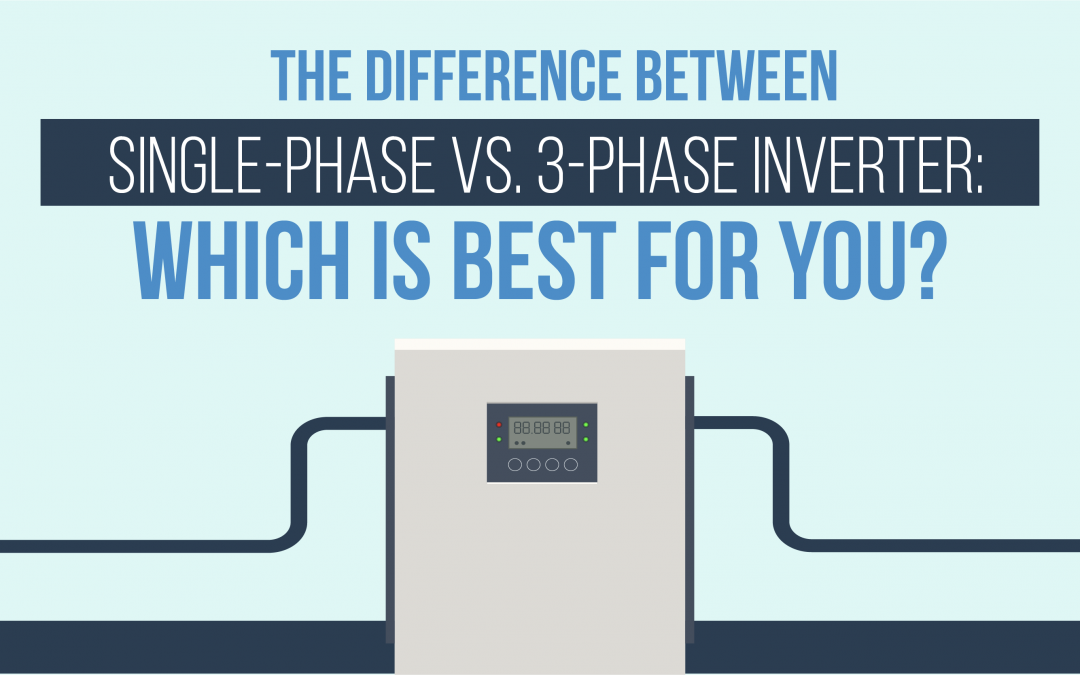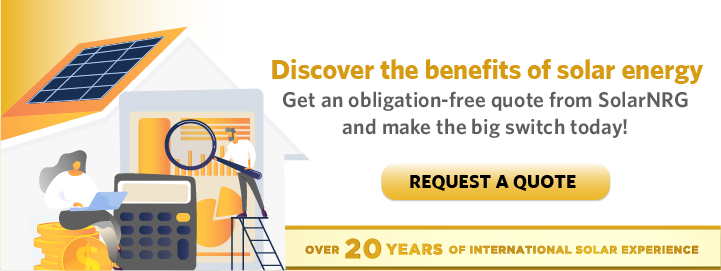Solar energy is a great way to lower electricity costs and carbon footprint, but have you ever wondered how sunlight becomes usable power? The answer to that question? Inverters.
Inverters are the machines responsible for converting the direct current (DC) that solar panels generate into alternating current (AC), which most home appliances and the electrical grid use.
Inverters may be single-phase or three-phase. Each type has strengths and unique designs for specific power needs, so you must understand their differences when choosing a solar system with the greatest impact on energy efficiency and cost savings.
Check the infographic below to learn more about single-phase and 3-phase solar inverters.

3-Phase vs. Single-Phase Solar: What Are They?
A single-phase inverter produces power through one voltage phase. It is common in residential applications due to its simplicity, cost-effectiveness, and suitability for smaller power loads typically found in homes.
It requires only two wires—one active and one neutral—and provides 240V power to a property. You may find it ideal for powering household appliances and lighting.
On the other hand, a 3-phase inverter creates three distinct voltage waveforms spaced 120° apart. This configuration allows for a continuous and balanced flow of electricity, making it suitable for commercial and industrial environments with higher power demands.
It uses four wires—three active and one neutral—enabling the provision of both single-phase (240V) and three-phase (415V) power from the same electricity supply.
While single-phase inverters are generally more affordable, 3-phase inverters offer higher power output, improved efficiency, and better load balancing for larger systems.
8 Major Differences between Single-Phase and 3-Phase Solar Phase Inverters
Which should you choose: solar single-phase or three-phase? Examine their key differences below to help you choose properly.
1. Voltage and power capacity
Single-phase inverters operate at a lower voltage and power capacity because they use only one AC waveform. They are typically suitable for residential settings with modest energy demands.
Three-phase inverters have a higher voltage and can handle much larger power capacities. As mentioned, they use three AC waveforms that are 120° out of phase with each other, allowing for a more efficient and balanced distribution of power. This feature makes the three-phase variant ideal for business and industrial applications.
2. Energy efficiency
The single-phase inverter’s design can efficiently handle residential and light commercial energy needs. However, these inverters may experience slightly higher energy losses under heavy loads because of their single waveform. Expect occasional voltage fluctuations, which might impact overall system efficiency and energy output.
Fortunately, a carefully designed system and load management can help these inverters provide reliable performance and contribute to cost-effective energy solutions.
On the other hand, three-phase inverters are more energy-efficient, especially in systems with higher loads. The balanced power distribution across three phases ensures a more stable and consistent voltage output, minimizing energy losses due to voltage fluctuations.
This characteristic benefits businesses with equipment that often requires high power inputs. Even with their heftier price tag, three-phase systems promise to deliver higher energy outputs and lower operational costs than single-phase iterations. Depending on your priorities, both are worth the investment.
3. Installation and cost
Single-phase inverters have simpler and less expensive requirements. Single-phases typically require fewer components, simplifying the setup and reducing labor costs. As a result, the initial investment in a single-phase inverter is generally lower than its three-phase counterpart.
This cost-efficiency makes single-phase inverters a popular choice for homeowners and small businesses seeking to adopt solar power without breaking the bank.
On top of the rudimentary requirements, three-phase inverters involve additional components like three- or even four-phase wiring. This complexity translates to higher installation costs because of the required specialized equipment, extra wiring, and experienced technicians.
However, this inverter’s heavy-duty performance and efficiency often justify its high upfront expenses. Its initial investment may be higher, but its long-term energy savings and system reliability outweigh the added costs.
4. Load balancing and distribution
Single-phase inverters are well-suited for residential settings with consistent, lower power demands. While efficient, these inverters must manage load increases effectively for optimal performance since proper load management helps maintain balanced power distribution for homes with predictable energy needs.
Three-phase inverters can accommodate more when it comes to load distribution and balancing. They prevent overloads for a more stable power supply, which is crucial for high-demand environments.
5. Grid compatibility
Single-phase inverters integrate seamlessly with the standard residential electrical grid. Since most homes operate on a single-phase power supply, these inverters are a straightforward and compatible choice for harnessing solar energy.
Meanwhile, three-phase inverters align with the electrical infrastructure typical in commercial and industrial settings. They can effectively handle the increased electrical loads associated with these operations, providing a reliable and efficient power source.
6. Scalability
The single-phase inverter’s design allows smaller opportunities for scalability but offers solid performance for many applications. That said, expanding their capacity may involve upgrades to the electrical infrastructure.
Though potentially complex, these enhancements can be an opportunity to improve overall system efficiency and effectively accommodate growing energy needs.
Meanwhile, three-phase inverters can efficiently handle increased power demand and are a more viable long-term investment for larger properties or businesses that require extensive energy.
Their increased power density allows for the same amperage delivery with smaller wires, making them more adaptable to future expansions.
7. Power quality and harmonics
Single-phase inverters may generate more harmonic distortion, leading to imbalances and increased harmonic currents, especially under varying load conditions. It may also impact system efficiency and, in some cases, lead to overheating.
Comparatively speaking, the three-phase inverter’s power distribution across three phases helps balance the load and reduce harmonic distortion.
However, remember that both inverter types have strengths and considerations depending on the application and system requirements.
8. Maintenance
Some consider single-phase inverters easier to maintain due to their simpler design. Routine inspections and cleaning are typically sufficient to ensure optimal performance. Their limitations may require more frequent checks if they operate at or near capacity when used for multiple applications.
Similarly, three-phase inverters have complex structures that may require specialized maintenance so that they remain robust and less prone to wear and tear. Then again, there are fewer maintenance interventions and lower associated costs than single-phase systems.
You only need qualified technicians for regular inspections and maintenance to ensure the inverters deliver optimal performance and achieve longevity.
Which Inverter is Right for You?
Single-phase and 3-phase inverters offer unique advantages tailored to specific energy needs, so understanding your power requirements is vital to choosing the right one. Are you a homeowner looking to reduce electricity bills? A single-phase inverter might be perfect. Do you need solar energy for industrial use? A three-phase inverter could be the ideal solution.
It’s all about knowing what you need to land on the perfect choice for all your solar inverter needs. Then, take the next step with the help of SolarNRG.
SolarNRG specializes in designing and installing single-phase and three-phase solar systems. Our expert team will assess your energy consumption, property, and budget to recommend the optimal solution.
Contact us today for a free consultation on your journey toward energy independence.


Recent Comments